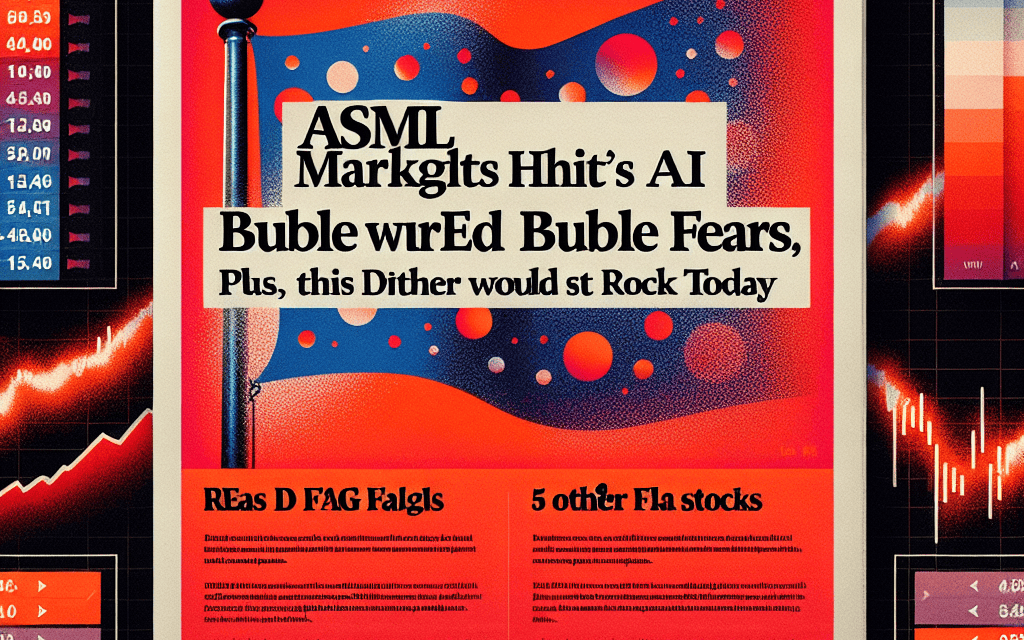“ASML Sounds the Alarm on AI Bubble: Key Market Shifts and Crucial Insights Unveiled.”
Introduction
ASML, a leading player in the semiconductor industry, has recently highlighted growing concerns about a potential bubble in the AI market. This apprehension is underscored by a significant red flag that could have substantial implications for stock markets globally. As investors and analysts closely monitor these developments, it’s crucial to understand the broader context and potential impacts. Alongside this, there are five other key developments today that warrant attention, each with the potential to influence market dynamics and investor strategies.
ASML’s Role in the AI Market and Its Impact on Stock Valuations
ASML Holding, a pivotal player in the semiconductor industry, has recently drawn attention to the burgeoning concerns surrounding the artificial intelligence (AI) market, particularly the fears of an AI bubble. As the demand for AI technologies continues to surge, ASML’s role in supplying advanced lithography machines, essential for producing cutting-edge chips, places it at the heart of this technological revolution. However, the company’s insights into the market dynamics have raised eyebrows among investors and analysts alike, as they highlight potential overvaluations in the AI sector.
The AI market’s rapid expansion has been fueled by an insatiable demand for more powerful and efficient chips, which are crucial for training and deploying AI models. ASML’s advanced extreme ultraviolet (EUV) lithography machines are indispensable in manufacturing these high-performance chips, making the company a linchpin in the semiconductor supply chain. Consequently, ASML’s performance and outlook are often seen as bellwethers for the broader tech industry. Despite the optimism surrounding AI, ASML has cautioned against the exuberance that has led to inflated stock valuations, reminiscent of past market bubbles.
Transitioning to the implications of these concerns, it is essential to consider how a potential correction in the AI market could impact stock valuations. If the AI bubble were to burst, it would not only affect companies directly involved in AI development but also those in the semiconductor industry, including ASML. A significant downturn could lead to a reevaluation of growth prospects and profitability, causing a ripple effect across the tech sector. Investors, therefore, need to be vigilant and discerning, distinguishing between genuine innovation and speculative hype.
Moreover, ASML’s cautionary stance serves as a reminder of the cyclical nature of technology markets. Historically, periods of rapid technological advancement have often been followed by corrections, as initial excitement gives way to more measured assessments of long-term viability and profitability. This cyclical pattern underscores the importance of maintaining a balanced perspective, even amidst groundbreaking technological advancements.
In addition to ASML’s insights, there are other factors that investors should consider when evaluating the AI market’s trajectory. For instance, regulatory developments could play a significant role in shaping the future of AI technologies. Governments worldwide are increasingly scrutinizing AI applications, particularly concerning data privacy and ethical considerations. Any regulatory changes could impact the pace of AI adoption and, consequently, the demand for related technologies.
Furthermore, geopolitical tensions, particularly those involving major semiconductor-producing regions, could also influence market dynamics. Trade restrictions or conflicts could disrupt supply chains, affecting the availability and cost of critical components necessary for AI development. Such disruptions could further exacerbate market volatility, adding another layer of complexity for investors to navigate.
In conclusion, while ASML’s position in the AI market underscores its critical role in the ongoing technological transformation, its warnings about potential overvaluations serve as a prudent reminder of the risks inherent in rapidly evolving markets. Investors must remain vigilant, considering not only the technological potential but also the broader economic and geopolitical factors that could influence market stability. By doing so, they can better navigate the complexities of the AI market and make informed decisions that align with their long-term investment strategies.
Understanding the AI Bubble: Key Indicators and Market Reactions
In recent months, the financial markets have been abuzz with discussions surrounding the potential for an artificial intelligence (AI) bubble. This concern has been underscored by ASML, a leading supplier in the semiconductor industry, which has highlighted the market’s growing apprehension. As AI technologies continue to advance and integrate into various sectors, the enthusiasm surrounding their potential has led to significant investments and soaring stock valuations. However, this optimism is not without its risks, as history has shown that rapid technological advancements can sometimes lead to speculative bubbles.
One of the primary indicators of a potential AI bubble is the rapid increase in stock prices of companies associated with AI technologies. Investors, eager to capitalize on the next big technological revolution, have poured substantial capital into these companies, often driving valuations to unprecedented levels. This phenomenon is reminiscent of past technological bubbles, such as the dot-com bubble of the late 1990s, where exuberance and speculation led to inflated valuations that eventually proved unsustainable.
Moreover, the market’s reaction to AI-related news and developments further illustrates the heightened sensitivity and volatility surrounding this sector. For instance, announcements of new AI products or partnerships often result in significant stock price fluctuations, reflecting the market’s speculative nature. While such reactions can be seen as a testament to the transformative potential of AI, they also serve as a cautionary tale of the risks associated with overvaluation and herd mentality.
In addition to stock price movements, another red flag that could signal an impending correction in the AI market is the disparity between company valuations and their actual financial performance. Many AI companies, particularly startups, are valued based on their potential future earnings rather than their current profitability. This disconnect can create a precarious situation where any failure to meet growth expectations could lead to sharp declines in stock prices, thereby impacting the broader market.
Furthermore, regulatory developments and geopolitical tensions also play a crucial role in shaping the AI market landscape. Governments worldwide are increasingly scrutinizing AI technologies, raising concerns about data privacy, ethical considerations, and potential job displacement. Any regulatory actions or policy changes could significantly impact the growth trajectory of AI companies, adding another layer of uncertainty to the market.
Despite these concerns, it is essential to recognize the genuine advancements and opportunities that AI technologies present. From healthcare and finance to manufacturing and transportation, AI has the potential to revolutionize industries and drive economic growth. However, investors must exercise caution and conduct thorough due diligence to differentiate between companies with sustainable business models and those riding the wave of speculative hype.
In conclusion, while the excitement surrounding AI technologies is well-founded, it is crucial to remain vigilant and aware of the potential risks associated with an AI bubble. By closely monitoring key indicators such as stock price movements, valuation disparities, and regulatory developments, investors can better navigate the complexities of the AI market. As the landscape continues to evolve, maintaining a balanced perspective will be essential in capitalizing on the opportunities presented by AI while mitigating the risks of a speculative bubble.
The Red Flag in ASML’s Market Performance That Could Affect Stocks
ASML Holding, a key player in the semiconductor industry, has recently drawn attention to the burgeoning concerns surrounding the artificial intelligence (AI) market, particularly the fear of an AI bubble. As the company navigates the complexities of a rapidly evolving technological landscape, its market performance serves as a barometer for broader industry trends. Investors and analysts alike are keenly observing ASML’s trajectory, as any significant shifts could have far-reaching implications for the stock market. The company’s insights into the AI sector are particularly noteworthy, given its pivotal role in supplying advanced lithography machines essential for semiconductor manufacturing.
The AI market has experienced exponential growth, driven by advancements in machine learning, data analytics, and automation. However, this rapid expansion has also led to apprehensions about a potential bubble, reminiscent of the dot-com era. ASML’s observations are crucial in this context, as they highlight the delicate balance between innovation and market stability. The company’s performance is not only a reflection of its operational prowess but also an indicator of the health of the semiconductor industry, which underpins the AI revolution.
One of the red flags that could significantly impact stocks is the potential for overvaluation within the AI sector. As companies rush to capitalize on AI technologies, there is a risk that valuations may become detached from fundamental realities. ASML’s cautionary stance serves as a reminder that while AI holds transformative potential, it is essential to approach investments with a discerning eye. The company’s insights underscore the importance of distinguishing between genuine innovation and speculative hype, a task that requires both technical expertise and market acumen.
Moreover, ASML’s market performance is intricately linked to global supply chain dynamics. The semiconductor industry has faced unprecedented challenges in recent years, from geopolitical tensions to supply chain disruptions. These factors have a direct impact on ASML’s operations and, by extension, its stock performance. Investors must consider these external variables when assessing the company’s market position, as they can significantly influence both short-term fluctuations and long-term trends.
In addition to these considerations, ASML’s role in the broader technological ecosystem cannot be overstated. The company’s cutting-edge lithography machines are critical for producing the advanced chips that power AI applications. As such, any developments within ASML have a ripple effect across the tech industry. This interconnectedness highlights the importance of monitoring ASML’s market performance, as it provides valuable insights into the trajectory of technological innovation.
Furthermore, ASML’s strategic decisions, such as investments in research and development or partnerships with other tech giants, can offer clues about the future direction of the AI market. These moves not only reflect the company’s growth strategy but also signal broader industry trends. Investors and analysts should pay close attention to these developments, as they can provide a competitive edge in navigating the complexities of the tech sector.
In conclusion, ASML’s market performance is a critical indicator of both the opportunities and challenges within the AI sector. While the potential for an AI bubble looms large, the company’s insights and strategic decisions offer valuable guidance for investors seeking to navigate this dynamic landscape. By understanding the interplay between innovation, market forces, and external variables, stakeholders can make informed decisions that align with both current realities and future possibilities.
How ASML’s Market Movements Reflect Broader AI Investment Trends

ASML, a leading player in the semiconductor industry, has recently become a focal point for investors concerned about the potential overvaluation in the artificial intelligence (AI) sector. As the company navigates the complexities of the current market, its movements offer valuable insights into broader investment trends surrounding AI technologies. The semiconductor industry, which is integral to AI development, has seen significant fluctuations, reflecting both the optimism and apprehension that characterize the current investment climate.
The rapid advancement of AI technologies has spurred a surge in demand for semiconductors, as these components are essential for powering AI applications. ASML, known for its cutting-edge lithography machines, plays a crucial role in the production of advanced chips. Consequently, the company’s performance is often viewed as a barometer for the health of the AI sector. However, recent market dynamics suggest that investors are becoming increasingly wary of a potential bubble in AI investments. This caution is driven by concerns that valuations may have outpaced the actual growth and profitability of AI technologies.
In this context, ASML’s market movements are particularly telling. The company’s stock has experienced volatility, mirroring the broader uncertainty in the AI sector. While some investors remain bullish, betting on the transformative potential of AI, others are more circumspect, worried that the current enthusiasm may not be sustainable. This dichotomy is emblematic of the broader debate over whether AI is on the cusp of a revolutionary breakthrough or if the market is prematurely pricing in future gains.
Adding to these concerns is a significant red flag that could have far-reaching implications for stocks across the board. The potential for regulatory intervention in the AI space looms large, as governments worldwide grapple with the ethical and societal implications of AI technologies. Increased regulation could slow down the pace of innovation and impact the profitability of companies heavily invested in AI. This possibility has not gone unnoticed by investors, who are closely monitoring regulatory developments that could reshape the landscape of AI investments.
Beyond ASML, there are several other factors that investors should consider when evaluating the current state of the AI market. First, the competitive landscape is rapidly evolving, with new entrants challenging established players. This increased competition could lead to price wars and margin pressures, affecting the profitability of companies in the sector. Second, the pace of technological advancement in AI is accelerating, which could render existing technologies obsolete more quickly than anticipated. Companies that fail to keep up with these advancements may find themselves at a disadvantage.
Moreover, geopolitical tensions, particularly between major economies, could disrupt supply chains and impact the availability of critical components for AI development. This uncertainty adds another layer of complexity for investors trying to navigate the AI market. Finally, macroeconomic factors, such as interest rate changes and inflation, could influence investment decisions and affect the flow of capital into the AI sector.
In conclusion, ASML’s market movements provide a lens through which to view the broader trends and challenges facing AI investments. While the potential for transformative growth remains, investors must also contend with a range of risks that could impact the sector’s trajectory. By staying informed and considering these various factors, investors can better position themselves to navigate the complexities of the AI market.
Analyzing the Potential Risks of Overvaluation in AI Stocks
In recent months, the rapid ascent of artificial intelligence (AI) stocks has captured the attention of investors and analysts alike, sparking both excitement and concern. ASML, a key player in the semiconductor industry, has recently highlighted the potential risks associated with the burgeoning AI market, drawing attention to what some perceive as an AI bubble. This concern is not unfounded, as the swift rise in valuations has led to fears of overvaluation, reminiscent of past market bubbles. As we delve into the potential risks of overvaluation in AI stocks, it is crucial to consider the broader implications for the market and the economy.
To begin with, the AI sector has experienced unprecedented growth, driven by technological advancements and increased demand for AI-driven solutions across various industries. This surge in interest has led to a significant influx of capital, with investors eager to capitalize on the transformative potential of AI technologies. However, this enthusiasm has also resulted in soaring stock prices, raising questions about the sustainability of such valuations. The fear of an AI bubble is further compounded by the fact that many companies in this space are still in the early stages of development, with unproven business models and uncertain revenue streams.
Moreover, the current market environment is characterized by a high degree of speculation, with investors often making decisions based on hype rather than fundamental analysis. This speculative behavior can lead to inflated valuations, as seen in previous market bubbles such as the dot-com bubble of the late 1990s. In such scenarios, stocks are often priced based on future growth expectations rather than current performance, creating a disconnect between market valuations and underlying business fundamentals. Consequently, any negative news or shifts in market sentiment could trigger a sharp correction, leading to significant losses for investors.
In addition to these concerns, the AI sector faces several external challenges that could impact its growth trajectory. Regulatory scrutiny is intensifying, with governments around the world grappling with the ethical and societal implications of AI technologies. Increased regulation could potentially slow down innovation and limit the growth prospects of AI companies. Furthermore, geopolitical tensions and trade disputes could disrupt global supply chains, affecting the availability of critical components and technologies necessary for AI development.
Despite these risks, it is important to acknowledge the immense potential of AI technologies to drive economic growth and innovation. The transformative impact of AI is undeniable, with applications ranging from healthcare and finance to transportation and manufacturing. However, investors must exercise caution and conduct thorough due diligence when evaluating AI stocks, focusing on companies with strong fundamentals, sustainable business models, and clear paths to profitability.
In conclusion, while the AI sector presents significant opportunities, it is not without its risks. The potential for overvaluation and the formation of an AI bubble is a legitimate concern that warrants careful consideration. Investors should remain vigilant and adopt a balanced approach, weighing the potential rewards against the inherent risks. By doing so, they can better navigate the complexities of the AI market and make informed investment decisions. As the landscape continues to evolve, staying informed and adaptable will be key to successfully capitalizing on the opportunities presented by this dynamic and rapidly changing sector.
The Influence of ASML’s Market Position on Global Tech Investments
ASML Holding, a pivotal player in the semiconductor industry, has recently drawn attention to the burgeoning concerns surrounding the artificial intelligence (AI) market’s potential bubble. As the sole supplier of extreme ultraviolet (EUV) lithography machines, ASML’s insights carry significant weight in the tech investment landscape. The company’s observations about the AI sector’s rapid expansion and the accompanying market exuberance have sparked discussions among investors and analysts alike. This discourse is particularly relevant as the global tech industry continues to grapple with the implications of AI’s meteoric rise.
The semiconductor industry, which underpins the AI revolution, is heavily reliant on ASML’s cutting-edge technology. Consequently, any shifts in ASML’s market position or strategic direction can have far-reaching effects on tech investments worldwide. The company’s recent cautionary stance on AI market dynamics serves as a reminder of the potential volatility inherent in rapidly evolving sectors. Investors are thus prompted to reassess their portfolios, considering the balance between high-growth opportunities and the risks of overvaluation.
Moreover, ASML’s influence extends beyond its immediate industry. The company’s technological advancements and market strategies often set benchmarks for other tech firms, shaping broader investment trends. As AI continues to integrate into various sectors, from healthcare to finance, the demand for semiconductors is expected to surge. However, ASML’s warning about a possible AI bubble suggests that investors should remain vigilant, ensuring that their enthusiasm for AI-driven growth does not overshadow prudent risk management.
In addition to ASML’s insights, several other factors are currently shaping the global tech investment landscape. Firstly, geopolitical tensions, particularly between major economies, have introduced a layer of uncertainty that could impact supply chains and market stability. Secondly, regulatory developments, especially those concerning data privacy and AI ethics, are increasingly influencing corporate strategies and investor sentiment. These elements, combined with ASML’s observations, underscore the complexity of navigating the tech investment terrain.
Furthermore, the rapid pace of technological innovation presents both opportunities and challenges for investors. While breakthroughs in AI and related fields promise substantial returns, they also necessitate a keen understanding of market dynamics and potential disruptors. ASML’s position as a leader in semiconductor technology provides it with a unique vantage point to assess these trends, making its perspectives particularly valuable for stakeholders seeking to make informed decisions.
In light of these considerations, it is crucial for investors to adopt a holistic approach when evaluating tech investments. This involves not only analyzing individual companies and technologies but also understanding the broader market forces at play. ASML’s recent commentary serves as a timely reminder of the importance of due diligence and strategic foresight in an era characterized by rapid technological change and market volatility.
In conclusion, ASML’s market position and insights significantly influence global tech investments, particularly in the context of the AI sector’s growth. While the company’s cautionary stance on a potential AI bubble highlights the need for careful risk assessment, it also emphasizes the importance of staying informed about broader industry trends. As the tech landscape continues to evolve, investors must remain agile, balancing the pursuit of innovation-driven growth with the imperative of managing potential risks.
Strategies for Investors Amidst AI Bubble Concerns and Market Volatility
In recent months, the financial markets have been abuzz with discussions surrounding the potential bubble forming in the artificial intelligence (AI) sector. ASML, a leading supplier of semiconductor manufacturing equipment, has highlighted these concerns, drawing attention to the rapid pace at which AI-related stocks have surged. This has led to growing apprehension among investors about the sustainability of such growth. As the market grapples with these fears, it is crucial for investors to adopt strategies that can help navigate the volatility and uncertainty that may lie ahead.
One of the primary strategies investors should consider is diversification. By spreading investments across various sectors and asset classes, investors can mitigate the risks associated with a potential downturn in the AI sector. Diversification not only helps in cushioning the impact of a market correction but also provides exposure to other growth opportunities that may arise in different industries. Furthermore, it is essential for investors to conduct thorough research and due diligence before making investment decisions. Understanding the fundamentals of companies, their competitive positioning, and growth prospects can provide valuable insights into their long-term potential, beyond the current market hype.
In addition to diversification, maintaining a long-term perspective is another critical strategy. While short-term market fluctuations can be unsettling, history has shown that markets tend to recover over time. By focusing on long-term goals and staying committed to a well-thought-out investment plan, investors can avoid making impulsive decisions driven by fear or greed. This approach not only helps in weathering market volatility but also allows investors to capitalize on opportunities that may arise during periods of market dislocation.
Moreover, investors should be mindful of valuation metrics when assessing potential investments in the AI sector. With the rapid rise in stock prices, some companies may be trading at valuations that are not justified by their current earnings or growth prospects. By paying attention to metrics such as price-to-earnings ratios, price-to-sales ratios, and other relevant financial indicators, investors can make more informed decisions and avoid overpaying for stocks that may be caught in a speculative bubble.
Another important consideration is the role of macroeconomic factors in shaping market dynamics. Interest rates, inflation, and geopolitical developments can all have significant impacts on investor sentiment and market performance. Staying informed about these factors and understanding their potential implications can help investors make more strategic decisions. For instance, in an environment of rising interest rates, growth stocks, including those in the AI sector, may face increased pressure, as higher borrowing costs can weigh on their valuations.
Finally, it is crucial for investors to remain adaptable and open to adjusting their strategies as market conditions evolve. This may involve rebalancing portfolios, exploring alternative investment opportunities, or even taking a more defensive stance during periods of heightened uncertainty. By staying flexible and responsive to changing market dynamics, investors can better position themselves to navigate the challenges and opportunities that lie ahead.
In conclusion, while the AI sector presents exciting growth prospects, the potential for a market bubble necessitates a cautious and strategic approach. By diversifying investments, maintaining a long-term perspective, paying attention to valuations, considering macroeconomic factors, and remaining adaptable, investors can effectively manage risks and capitalize on opportunities amidst the current market volatility.
Q&A
1. ASML’s recent market performance has raised concerns about a potential AI bubble.
2. Investors are worried that the AI hype may be inflating stock valuations beyond sustainable levels.
3. A significant red flag for the market would be a slowdown in AI-related revenue growth.
4. Such a slowdown could lead to a broader market correction, impacting tech stocks heavily.
5. Other key market updates include economic data releases and central bank policy announcements.
6. Analysts are closely watching corporate earnings reports for signs of economic resilience or weakness.
7. Geopolitical tensions and their impact on global markets remain a critical area of focus for investors.
Conclusion
ASML’s recent highlights underscore growing concerns about a potential AI market bubble, driven by heightened investor enthusiasm and speculative investments. The company’s insights suggest that while AI technology holds transformative potential, the current market dynamics may not be sustainable, posing risks to stock valuations. A significant red flag that could impact stocks is the potential for regulatory changes or technological setbacks that might deflate the AI hype. Additionally, investors should be aware of broader economic indicators, geopolitical tensions, and shifts in consumer demand that could influence market stability. Overall, while AI remains a promising sector, caution is advised due to the volatility and uncertainties surrounding its market trajectory.





